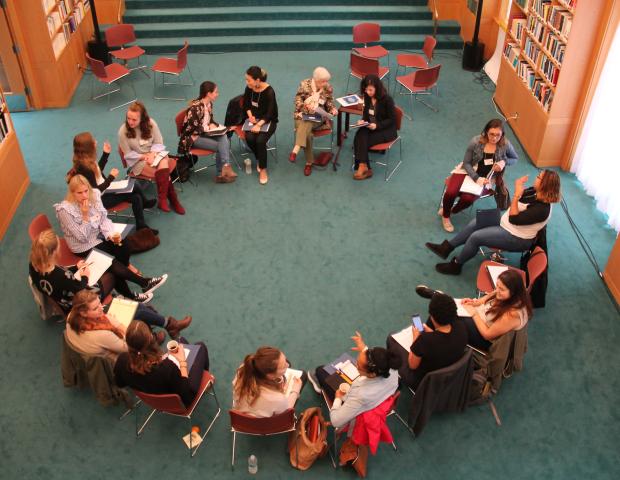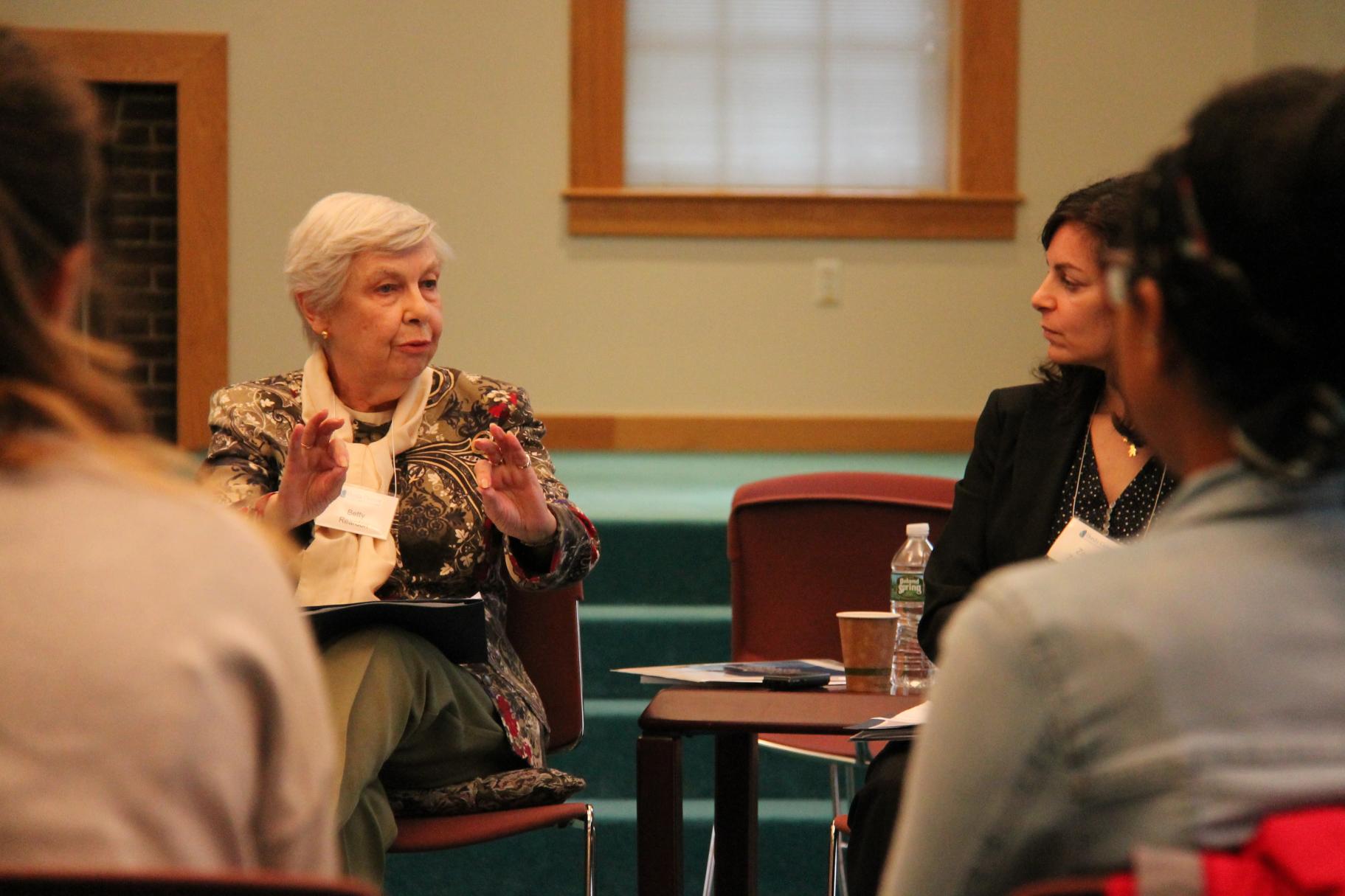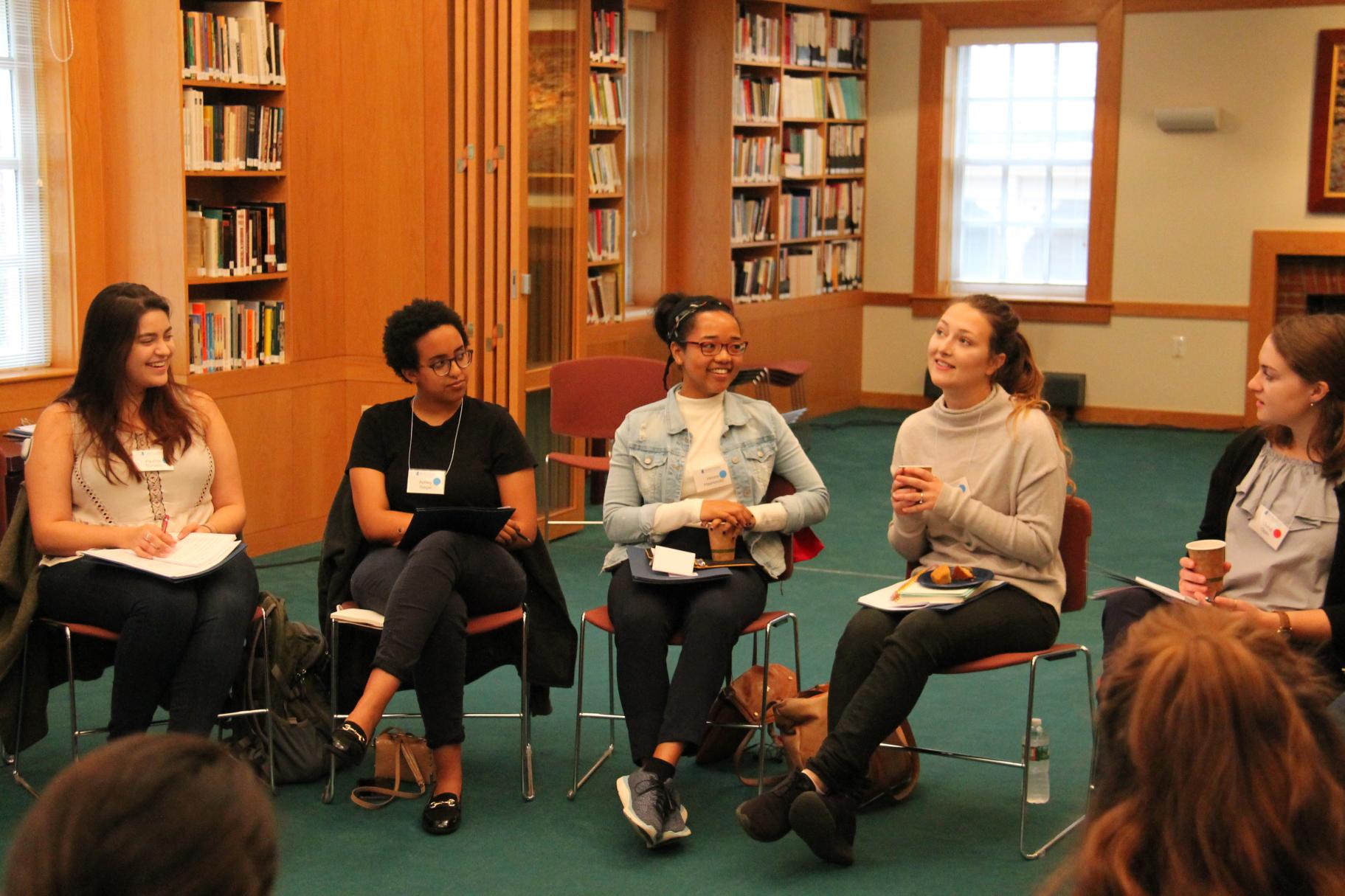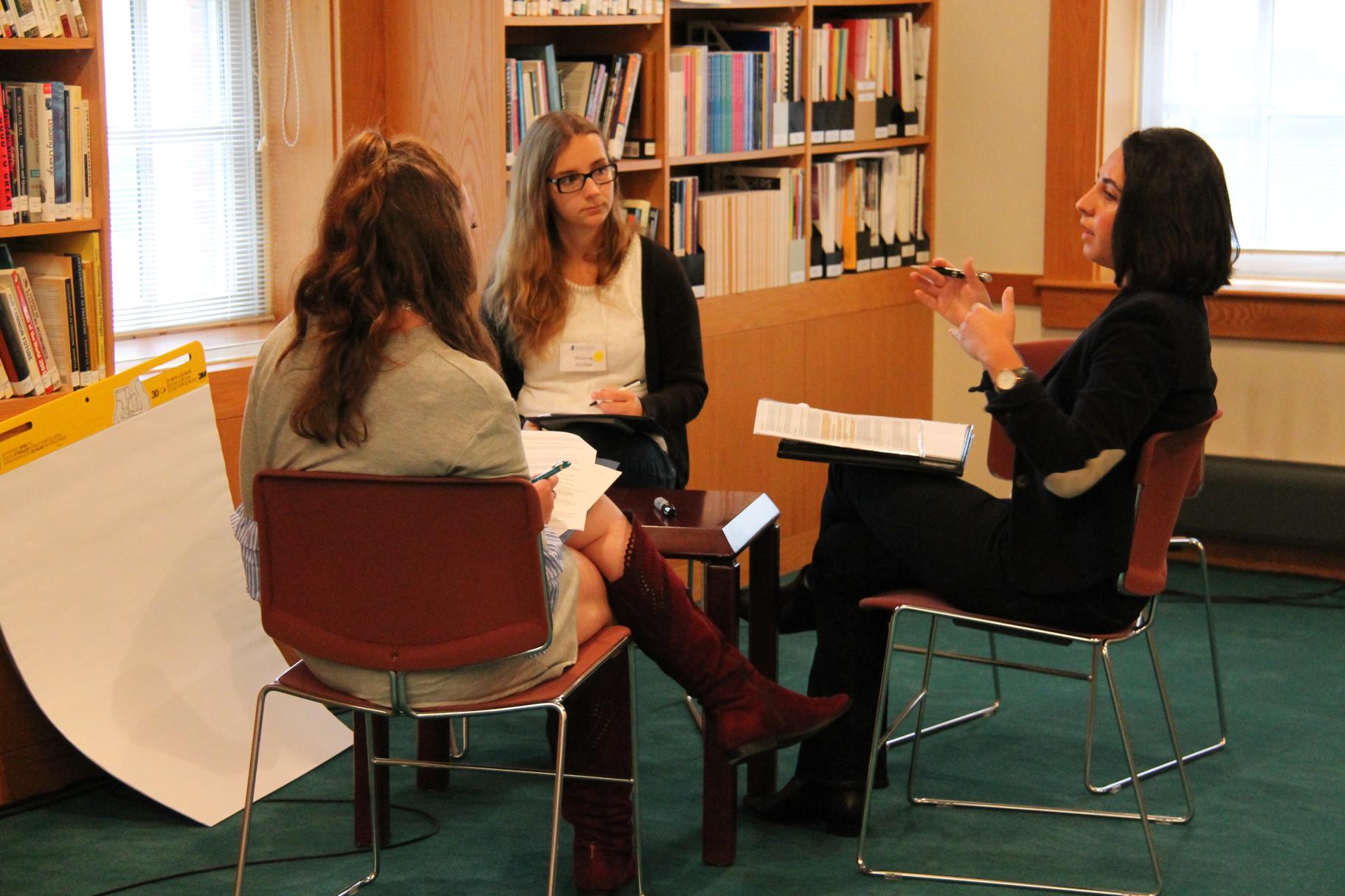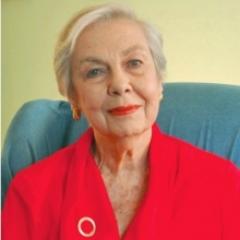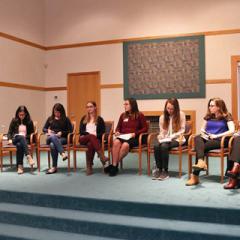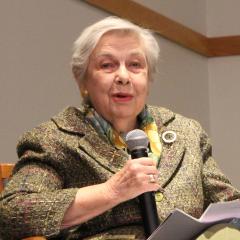Report From the Second Nuclear Abolition Seminar
Here, Mitch Bogen reports from the second student-scholar nuclear weapons abolition seminar, held February 2018, following the first one, which was held a few months earlier, in the fall of 2017. Once again, proceedings were facilitated by Betty Reardon and Zeena Zakharia.
New Awareness, Visionary Practicality, and Nuclear Weapons Abolition
The Ikeda Center’s February 10, 2018, student seminar on the topic of nuclear weapons abolition didn’t proceed according to a schedule. Rather, it proceeded with what facilitators Betty Reardon, a pioneer in peace education and feminist studies, and Zeena Zakharia, Assistant Professor of International and Comparative Education at UMass Boston, identified as a “learning sequence.” That is to say, the daylong event was carefully structured in order to elicit from students their considered impressions of the major obstacles to nuclear weapons abolition, and then to help them visualize a clear sequence of action steps that ultimately will result in the entering into force of the 2017 Treaty on the Prohibition of Nuclear Weapons. Building on those learnings, the seminar then concluded with students exploring an agenda for a public event to be held at the Ikeda Center on April 21 during which they will share their newly-developed strategy for a world free of nuclear weapons.
The February seminar was the second of two, with the first taking place last fall, also with Reardon and Zakharia facilitating. During that seminar, student participants engaged with Center founder Daisaku Ikeda’s writings on the topic of nuclear weapons abolition. In particular, they considered what Dr. Reardon describes as “alternative modes of thinking” capable of disrupting the dismal status quo in which various “realists” and others claim that there is simply nothing that can be done to deal with this threat. During the time between seminars, participants engaged in dialogue with various people in their lives as an initial effort to gauge the level of knowledge and range of beliefs and commitments that exist around this topic. They also researched civil society actions toward nuclear disarmament.
Ikeda Center executive director Virginia Benson opened the day by welcoming the participating students, eight of whom were returning, and three of whom were first-time attendees. The eleven students represented six area universities. Benson’s remarks focused on Daisaku Ikeda’s 2018 peace proposal, “Toward an Era of Human Rights: Building a People’s Movement.” She said that for Ikeda, “the human rights approach is key” to resolving global issues of every sort, including the threat of nuclear weapons. Here she quoted Mr. Ikeda, who urges us to make the “life and dignity of each individual our focal point,” embracing “the fact that every human being is inherently precious and irreplaceable.” She concluded, saying:
On behalf of the staff of the Center, I want to express our sincere hope and dream that the time you have today to learn together with two great peace educators, Betty Reardon and Zeena Zakharia, will not only become an inspirational memory but will also strengthen the capacity and the will of all of us to respond to this great challenge of our time.
Assessing Where We Are At
For the initial learning activity, Dr. Zakharia invited students to pair up to discuss what they learned about nuclear weapons abolition from dialogues they engaged in since the first seminar; or, if they were new attendees, what concerns about nuclear weapons inspired them to attend. The focus here would not only be on content, however. Rather than sharing their own thoughts with the group, students were tasked with reporting their understanding of what their partner expressed—listening being perhaps the most essential dialogic tool, and as such critical to the kind of coalition building, small and large, the quest for nuclear abolition requires.
Highlights from the student reporting included:
- The technology we develop to better connect us also tempts us into denial about nuclear destruction.
- Discussions on nuclear issues are often too “short-lived,” with individuals losing motivation in the face of such a distant goal. “Ordinary citizens don’t know what to do about the issues plaguing us now.”
- Discussions with older individuals sometimes reveal less commitment to nuclear abolition. “What was the experience that the older generation had,” asked one student, “that made their opinions so different than ours, and how can we learn from it and use it?” One participant, a European citizen, mentioned in response the sense of security that her grandparents’ generation derives from nuclear weapons, after surviving World War II.
- One way to find common ground with older generations is to realize they “are invested in making sure their children and grandchildren don’t experience nuclear fallout.”
- Older generations also can at times be less inclined to think as much in global terms as younger generations do. “People are thinking inside their own box of safety and do not realize how much of a universal impact” nuclear weapons can have.
- It seems dangerous that one individual can possess so much power to launch nuclear weapons with so little corresponding accountability.
- It is disturbing how disinclined our leaders seem to be to tackle this challenge, “but in reality we have to ask the American people to take a stand on this in order to instigate change.”
- It could be that nuclear weapons abolition is actually more achievable than ending climate change, since a series of concrete steps are involved.
This first exercise was intended to produce information, to help establish the landscape; it also aimed to produce ideas that were, as Reardon phrased it, “provocative,” capable of “making me think.” And if there was a note of discouragement regarding government action sounded throughout the brainstorming, Zakharia emphasized that at this point it’s not necessary to count on politicians, including the current US administration, to take action. Civil society, she said, can move forward regardless, and help create the conditions for effective political action.
Up to this point Dr. Reardon had offered only brief comments. Now she offered in-depth reflections based on her long experience—reflections intended both to contextualize the issues raised by the students and to offer encouragement in the face of their concerns. Her first point dealt with the emerging concept of global citizenship. Though variations on the idea have existed for decades, Dr. Reardon said that she feels that now it is steadily moving from dream to reality. It is her perception that national identifications are no longer paramount among participants in global peace movements, who increasingly interact on the basis of shared interests and values, and a common concern for humankind. This reflects a realization that nation-states are man-made, and are not inherently sacred or unchangeable.
So many of us seem to be sleepwalking in the presence of the nuclear weapons threat.She acknowledged there is a lack of urgency about the nuclear threat, saying that so many of us seem to be “sleepwalking” in its presence. This, she said, may have something to do with the fact that for most of the population, nuclear weapons have always just been there, a fact of life. Given this state of affairs, it is wise to focus on the practicality of steps that will get us from where we are to where we need to be. Here, she referenced the recently deceased theorist of nonviolent social change Gene Sharp, who argued for something he called transarmament, an interim stage toward disarmament as nonviolent mechanisms of dispute settlement are developed. This means that advocates for the demilitarization of a nation-state must not be content with bringing down a system but must simultaneously be involved with the raising up of alternative peaceful systems.
Finally, Reardon talked about the nature of and need for coalition building when tackling ambitious projects such as nuclear disarmament. Coalition building is “how possibility can become reality,” she said, and is exemplified by winners of the 2017 Nobel Peace Prize, the International Campaign to Abolish Nuclear Weapons. ICAN was honored in particular for its leadership role in the July 2017 UN adoption of the Treaty on the Prohibition of Nuclear Weapons and in general “for its work to draw attention to the catastrophic humanitarian consequences of any use of nuclear weapons and for its ground-breaking efforts to achieve a treaty-based prohibition of such weapons.”
Why did ICAN succeed? In large part, said Reardon and Zakharia, they and other coalitions have succeeded because constituent groups have been less purist or dogmatic in orientation. Dr. Reardon observed that until recently, organizations participating in peace-oriented coalition building too often interpreted the task of collaboration to mean that they should convince the other organizations to “sign on” to their preferred method. The success of ICAN, said Reardon, offers a different vision, one where individuals make unique contributions, but more important, “come together to build our common power” in pursuit of a shared goal. Dr. Zakharia added that when you have a common goal, you don’t necessarily have to have “these other things in common,” In fact, expecting to have everything in common simply “is not viable.”
Clear-Eyed Assessments
Where Reardon’s reflections offered a widening out of perspective, the next phase of the learning sequence represented a narrowing back in, as students were asked to dialogue in small groups to be “clear-eyed” about our current situation in order to create a short list of what they see as the core obstacles to nuclear disarmament. She emphasized, however, that being clear-eyed should not be interpreted as acquiescing to the notion that violence or coercion are somehow more “practical” than nonviolence when seeking political or social change. After all, few thought that the liberation of South Africa from the apartheid system could happen, she observed, without a violent overthrow.
The student dialogues produced a list of obstacles that coalesced around several interdependent, overlapping themes.
- First of all is the mindset that paralyzes us in the face of this daunting problem. “People know, but don’t act,” which is why we have to challenge that mode of thinking and “instill urgency.”
- Closely related is the difficulty of changing the current status quo, especially since the “effects of nuclear weapons are so distant from the average person.”
- The first two are tied to an overall lack of awareness among regular people about anything having to do with nuclear weapons related issues.
- Our institutions and authorities are both unaccountable to the people for their lack of action, but also “reactionary in nature,” taking action usually only in response to extreme incidents, which is far too risky.
- Finally is the crippling lack of trust among nation-states, which is a big problem since “total disarmament is needed.”
Reardon reflected on several of these student findings, saying “all of these obstacles have come together for me as one common problematic, “ which “could be subsumed under [the concept of] mindset.” The question then is how to change mindsets. Referencing the first seminar, Reardon reiterated that our current modes of problem solving have not proven “adequate to this crisis.” So how then, do we facilitate the needed change? Speaking from her perspective “as an educator,” she said we must offer possibilities that are at once provocative and constructive. Further, when “we enter into dialogue, it is best for us to enter with questions rather than answers.” Meeting the answers of others with questions rather than refutations is one way to build “a common capacity and a common understanding.”
As for the matter of accountability, the question is not so much how to keep leaders accountable but rather to ask how each and every one of us can infuse accountability into “what we do or try to make happen in the public sphere.” This relates directly to the matter of awareness of consequences, she said. How much of our deficit of knowledge here is intentional, she asked, a way of granting ourselves “deniability” and “distancing [ourselves] from responsibility over and over again?”
Finally is the matter of trust, which Reardon identified as “the basis of communicating,” adding that trust is also “the basis of a healthy relationship. And we have really, very sick relationships in the world among the major actors, and … within nations as well. We have very unhealthy relationships with people who don’t think the same way we do.” An effective way to overcome this situation, she said, is to treat our efforts at engagement as learning processes. By learning together and imagining alternatives we might be able to revive a sense of trust among those with differing points of view.
Envisioning Possibilities
Transitioning to the next learning activity—the envisioning of positive possibilities for abolishing nuclear weapons—Dr. Reardon shared a foundational insight from the systems theorist Kenneth Boulding, who said, “What exists is possible.” When we look at all the instances of successful peacebuilding that have occurred in our world, suggested Boulding, we should take heart and believe that even if these triumphs sometimes have been small or isolated, we can build and expand upon them.
Reardon also advised that for inspiration and to get a sense for what constructive action steps look like they should refer to their handout featuring the ideas of Daisaku Ikeda and Ira Helfand, a 2017 Nobel Peace Prize recipient as a member of the steering committee of ICAN. Ikeda and Helfand, said Reardon, “have looked at the consequences of nuclear war in great detail,” and simply “will not accept that there isn’t an alternative.” She also pointed out how the actions are multidimensional, with Helfand’s oriented more toward steps the US government can take to diminish the nuclear threat, while Ikeda’s are more international in nature, seeking to inspire and prepare global civil society for action.
With that, participants broke into three groups to consider the question of “How might the possibilities fit into a transition strategy?” Their responses were wide ranging, creative, and pragmatic.
Group One. The focus here was on creating a sequence of possibilities. First is a focus on raising awareness, “normalizing” the topic for people. This process can include required coursework. Next, comes the development of strategy, including the setting of milestones. Finally, is the execution of the strategy, which above all stresses the positive over the negative and specific visualizations of what peace looks like.
Group Two explored the various modes of awareness around nuclear abolition that need to be activated. The primary forms of awareness are 1) awareness of humanitarian and environmental implications, as shown in stories of the hibakusha, and 2) awareness as manifested through empathy. These modes of awareness radiate out, from individual awareness, to awareness within close relationships, to shifts in immediate community mindsets, to political activity and coalition building, all resulting in an influential movement “grounded in accountability, empathy, trust, and love.”
Group Three. The focus here is on how to increase and improve conversations around nuclear disarmament. The first idea is to reframe the topic. For example, move it out of the dated Cold War context, and define it in terms of today’s needs. Further, the topic needs to be less taboo, with people feeling capable of discussing it casually. Finally, connect with and place in the context of contemporary movements, such as environmental.
In response, Reardon underscored two points in particular raised by the students. First, she said, “I think it’s very significant that you focus so much on awareness,” especially in acknowledging that the goal is not just “building awareness out there [socially] but building it in here [personally].” This way, when you pursue dialogue and knowledge building, “you are ready with your own awareness to engage with the awareness of others.” She also seconded that it is “important strategically” to intentionally find intersections and common ground with other issues and goals, especially with the climate change–environmental movement. These two movements are “very much interrelated and have common strategies that they can use,” she said. “So it would be more powerful for both movements, were they to work together synergistically. It’s all really very encouraging.”
We need new ways into the nuclear abolition conversation.Zakharia highlighted the importance of Group Three’s insight that we need new ways into the nuclear abolition conversation. It is vital to keep in mind, she said, that entry points will always include both formal and informal actions. The latter includes expressions in the arts and media, which can provide inviting and creative ways to approach polarizing issues.
Reardon followed up on this notion of entry points, urging participating students to start where they are, to see their natural field of action as their universities. Crucially, she said, the legacy of student movements shows that their impact extends beyond the campuses of which they are a part. One significant example in the United States of the 60s and 70s was Students for A Democratic Society. Campus-based, they made their voice heard throughout civil society and in political domains. “And those same years,” she added,
when there were authoritarian governments throughout Latin America, it was the students who organized and brought the movements for change. And the change of governments was largely the result of the efforts and commitment of the youth who were looking to their own future and just didn’t want their future to be the present, as none of us want the futures of any of the people we care about to be the present.
Reardon added that one less known but critical achievement of the student movements was the establishment of peace studies curricula at many universities. Like those trail blazing students, said Reardon, the students gathered today represent a “nucleus” capable of contributing to the cause of peace and the movement for nuclear weapons abolition. The purpose, she noted, is to “invite others into a common energy for change.”
Mapping the Future
The afternoon session employed a variation on what social scientists call “backward design.” Students were asked to create a “futures chronology of the history of abolition.” They were to proceed not by starting at the present time but by starting with the future “reality” that the 2017 Treaty has been entered into force, becoming international law in 2029, and then filling in the several major events that would need to happen to arrive at that point. Anticipating the obvious question of “Why 2029?” Reardon said that one reason, quite personal in nature, is that that is the year she will turn one hundred years old! The more important reason, she said, is that in ten or twelve years seminar participants will be coming into their own as leaders in the fields of their choosing.
When mapping interim milestones into their chronologies, suggested Reardon, they should bear in mind the centrality of “the threshold event.” These events change the conversation around an issue in such a way as to make breakthroughs possible. For example, as their scenario’s timeline shows, in 2014, three years prior to the UN adopting the Treaty on the Prohibition of Nuclear Weapons in 2017, 158 states convened for the Vienna Conference on the Humanitarian Impact of Nuclear Weapons. In the view of Mr. Ikeda and others, it was this gathering that set the stage, intellectually and morally, for the 2017 adoption. “Once humanitarian effects became a primary consideration about nuclear weapons, that was the watershed,” said Dr. Reardon. That’s where the “urgency” came from. What kind of an event, she asked, might constitute a threshold event for the 2029 ratification?
The students broke into three groups to brainstorm and develop their scenarios chronology. The scenario’s timeline they worked with began in 1947, with the first United Nations Resolution on the Elimination of Nuclear Weapons, an event that showed that deep concern for the destructive and antihuman capacities of nuclear weapons has been there since day one, baked into the nuclear reality. Other events leading up to 2017 listed on the timeline included “scares” such as the Cuban Missile Crisis of 1962 and advancements such as the entering into force of the Nuclear Non-Proliferation Treaty in 1970.
Before students reported on their findings, Dr. Reardon reflected on how the cause of nuclear weapons abolition sort of “fell off the table” after peaking as a powerful movement during the 1980s. What we need, and what this seminar series is devoted to, she said, is both an “awakening and reawakening” of nuclear disarmament as a cause embraced and shaped by ordinary citizens.
Led by Zakharia, the group then engaged in a dialogical collating process to come up with this chronology.
2018. Two groups concurred that a Nuclear Abolition March, in the mold of the Women’s Marches, or perhaps a Nuclear Abolition Day, would be excellent modes of awareness building. The other group proposed a more personal approach, one aimed at facilitating ways that each individual might better understand his or her own “scope of knowledge.”
2020. Students suggested that by this milestone there would be mandated nuclear weapons abolition curriculum is schools; that as a society we would see less reliance on nuclear energy in general; and that nuclear weapons abolition would be explicitly addressed in the presidential debates.
2022. Political pressure can be increased and awareness raised by groups working to make nuclear weapons abolition central to the mid-term elections. Methods and policies for employing nuclear weapons should be changed by this point to provide for greater safety and accountability.
2024. By this date, Japan will have become a signatory of the Treaty, joined by a great number of other countries. Mayors of cities globally will have issued a declaration in favor of nuclear weapons abolition.
2026. A concrete action plan will be developed for both nuclear weapons disarmament as well as any replacement measures that are needed.
Reflecting on these milestones, Dr. Reardon commended the group for their “visionary practicality,” saying that all of the suggestions are “viable,” but also “tough.” From these, she said, we can certainly “distill a common course of action.”
Toward the Public Event
The final activity was to draw from the day’s learning sequence to decide the agenda for the April 21 public event, as well as to identify the concrete actions students would pursue prior to the event. Zakharia led an initial discussion of where they think their actions should start.
Much of this initial discussion focused on the dimensions of awareness building, with the agreement that this is the foundational action, and one that cannot be passed over. One student suggested that a key aspect of nurturing awareness is to always have follow-up activities planned; otherwise any awareness raised in a conversation might easily dissipate. Thus, attention should be paid to what follows April 21. Other students talked about modes of awareness building. One way to build awareness is to ask “simple questions” of your friends, asking why they do or don’t care about this issue. Another is to build awareness through activities focused on “knowledge building.” Could the April 21 event include “mini-lectures” on key facts on the state of nuclear weapons and efforts to abolish them? And if so, who would deliver them? It was clear to Dr. Reardon that the students should.
Reardon reminded students to think about what gap they can fill.With these ideas in mind, Reardon offered some insights to help students focus in on what their most effective actions might be. First, she urged students to ask themselves what each of them, individually, would truly want to do, and then use that as the starting point for enlisting others. Next, she reminded students that they should think about what gap they can fill, and reiterated that the university is a natural site for their actions. Indeed, if institutional change is a necessary part of any socio-political change, then whatever they can do to effect change at their respective educational institutions would be a valuable contribution. In response to a student’s concern that this might mean not reaching older generations that are caught in the status quo, Zakharia said that the university can always be an engine for broader change.
With students agreeing that awareness building is the first task, Zakharia led a brainstorming discussion of potential methods and goals for this campaign. Regarding the former, it was agreed that a social media campaign makes the most sense, mixing videos, photos, geographic mapping, viral hashtags, and material posted to Facebook, Instagram, and Twitter. Ideas included:
- Combine reflection and action (individual & collective)
- Institutional change, for example, new curriculum at universities
- Collecting statements of commitment
- Political action
- Collection of signatures
- Creating unique messages for different audiences & generations
- An interdisciplinary approach: mixing academic and practitioner disciplines, and spanning across fields and industries
- Relatable to general public
- Connect to professions
- Employ strategic messaging, use language of audiences
Here, Zakharia asked students to distinguish between actions leading up to April 21, purposes for the event itself, and actions that would follow April 21. It was decided that in preparation, the three groups could produce videos that were exploratory and generative of ideas, assessing where their peers actually stand on the issue of nuclear weapons. A number of issues were in play:
- How many questions should we prepare for interview subjects?
- What kind of messaging or framing should be utilized? Should nuclear weapons abolition be up front, or secondary?
- What kinds of questions will elicit the best responses? Should they be fact-based? Or would feelings-based questions allow people to feel less intimidated and open up more, since they can’t be reduced to right and wrong?
With so many ideas being floated, Dr. Reardon suggested that since the plan for April 21 is for presentations from three student panels, it makes sense to create three interview videos, each answering a unique question, and with each panel building off the content of one of the videos. Thinking out loud, she wondered what the relationship between the three questions should be. Should the videos each address one layer of the issue, for example awareness, urgency, or action? After trying out different framing phrases, and proceeding through an iterative process, the group settled on working versions of the three questions for video interviews:
- What would you say if someone were to tell you that it only takes one person to launch a nuclear war? (Alternately, include how many people could be killed.)
- Do you think abolishing nuclear weapons is possible in your lifetime?
- When was the last time you were worried about nuclear war?
Conclusion
In a post-seminar conversation with Dr. Reardon, I asked her about the day’s process, in which the group continually moved back and forth between expanding outward through brainstorming and information-gathering activities and honing in on essential points and action steps, which became more specific with each iteration. She told me that this is an intentional, time-tested structure, one that she likened to a birthing process. It is rigorous and often painful, yet the results are to be rejoiced.
This invites the question, then, of what, exactly, was being born—not only during this day, but also across the span of the two seminars. Well, there was the emerging sense that achieving nuclear weapons abolition is less a battle to be won than a creative endeavor to be embraced. There was commitment, perhaps not fully new, but deepened. There was fresh urgency combined with a new sense that the goal of nuclear weapons abolition is actually achievable. There was the reality of a community being born—that “nucleus” Reardon spoke of, capable of transformative power.
Perhaps most uniquely was the birthing of a way of being in which generations, here spanning nearly seven decades, might work together as equals on behalf of humanity. If Reardon and Zakharia brought more experience and knowledge to the discussion, it was not as a show of hierarchical standing, but rather as a way to focus the insights and ideals of the young participants, all of whom are determined not to be among the sleepwalkers passively accepting the prospect of nuclear annihilation, and all of whom are devoted to helping each of us, no matter our age, awaken to our capacities for the peaceful advancement of our interdependent world.
